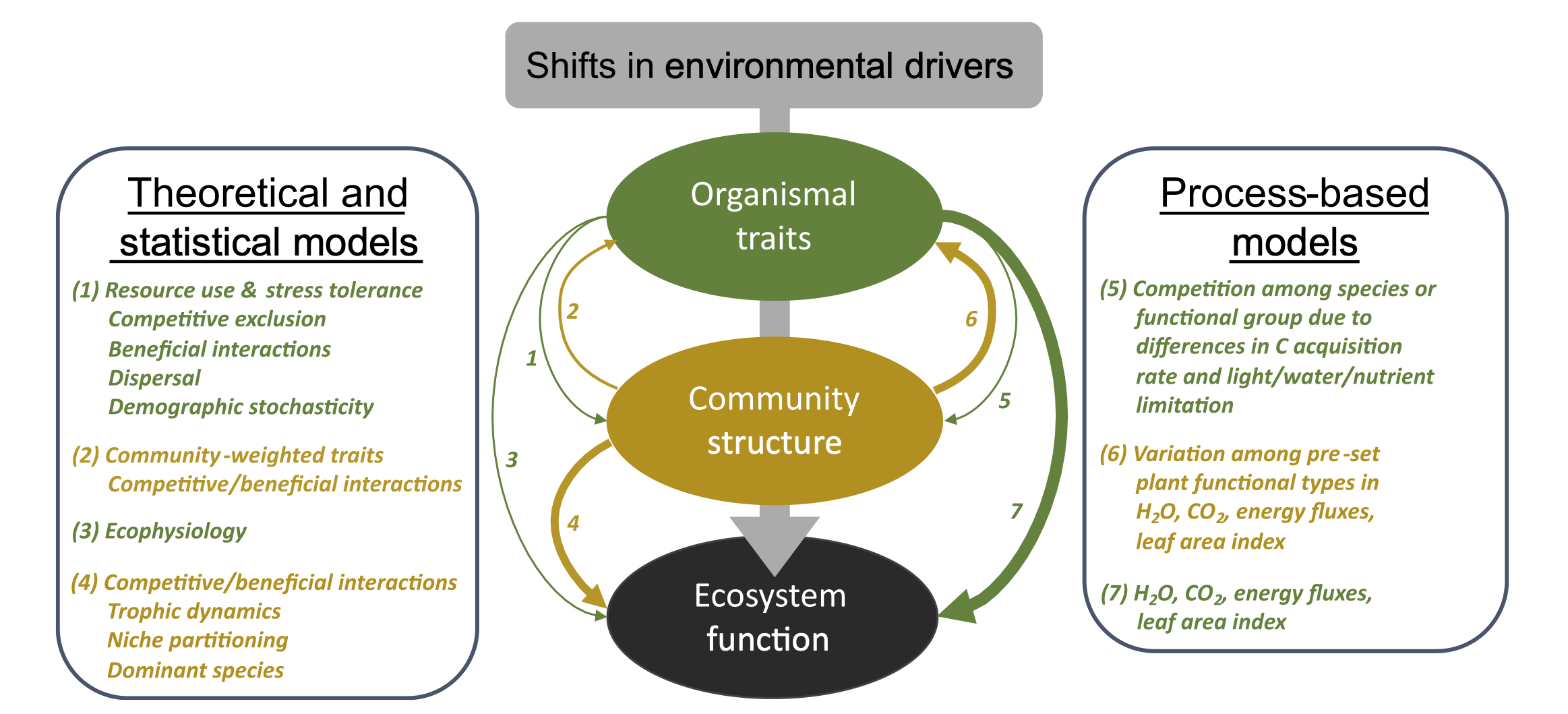November 03, 2020
Advancing Functional Understanding of Grassland Community Dynamics
Collaborations between empiricists and modelers are needed to achieve mechanistic understanding of the causes and consequences of plant community dynamic

Conceptual figure showing how ecologists bridge hierarchical scales (ovals) using both statistical and process-based models to predict how ecosystem function will respond to shifts in environmental drivers.
[Reprinted with permission from Wilcox, K.R., et al. “Improving Collaborations between Empiricists and Modelers to Advance Grassland Community Dynamics in Ecosystem Models.” New Phytologist 228 (5), 1467–1471 (2020). [DOI: 10.1111/nph.16900] © 2022 The Authors. New Phytologist © 2022 New Phytologist Foundation]
The Science
A plant community is the different types of plants and how abundant they are in an ecosystem. Changes in a grassland community can lead to changes in that grassland’s function. Community changes have been observed in reduced rainfall experiments, with changes in rainfall affecting grassland function both directly through plant responses to reduced rainfall and indirectly through shifts in the plant community. Yet, computer models of grassland function have limited capabilities in predicting these community changes. This study develops a roadmap for scientific collaboration between experimenting and modeling scientists.
The Impact
The developed roadmap shows how collaboration can help to overcome the limitations of working in isolation and lead to better understanding of how grassland function and plant communities respond to global change. Ecosystems are complex systems and responses to environmental change have multiple layers that interact (see image). Community ecologists need to start understanding the causes of community changes, while modelers need to develop better ways to represent key processes in grasslands. Working together will help to accelerate these goals.
Summary
Grassland plant communities have been observed to shift in response to experimentally altered environmental conditions. The shifts in community structure led to major shifts in the functioning of these grassland ecosystems. Yet models of grassland ecosystem function are unable to accurately predict these shifts in community structure. On the other hand, the changes in community structure observed in the experiments cannot be explained mechanistically. In other words, scientists cannot pinpoint why these changes happened. This study describes the discussions and conclusions from a series of meetings supported by the National Center for Ecological Analysis and Synthesis (NCEAS). These meetings brought together community ecologists and modelers to better understand grassland responses in global change experiments. To understand and predict shifts in community structure in response to global change and its effect on ecosystem functioning, scientists must identify: 1) the key mechanisms driving shifts in community structure; 2) how functional traits of plants change interact with these mechanisms to drive changes in community structure, and 3) how community dynamics alter the distribution of traits across the entire community and alter ecosystem function. These goals will be best achieved when experimenters and modelers (theorists) work together to overcome some of the limitations of isolated empirical studies and incomplete models.
Principal Investigator
Anthony Walker
Oak Ridge National Laboratory
[email protected]
Program Manager
Daniel Stover
U.S. Department of Energy, Biological and Environmental Research (SC-33)
Environmental System Science
[email protected]
Funding
This project was supported by the National Science Foundation (NSF) Synthesis Group ‘Integrating plant community and ecosystem responses to chronic global change drivers: toward an explanation of patterns and improved global predictions’ (DEB#1545288). This group is part of the Long Term Ecological Research (LTER) Network Communications Office, housed in the National Center for Ecological Analysis and Synthesis (NCEAS) at the University of California–Santa Barbara.
This project was also supported by the FACE Model Data Synthesis project, which is funded by the Office of Biological and Environmental Research (BER), within the U.S. Department of Energy’s (DOE) Office of Science.
References
Wilcox, K.R., et al. "Improving Collaborations between Empiricists and Modelers to Advance Grassland Community Dynamics in Ecosystem Models." New Phytologist 228 (5), 1467–1471 (2020). https://doi.org/10.1111/nph.16900.

